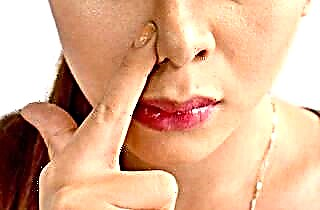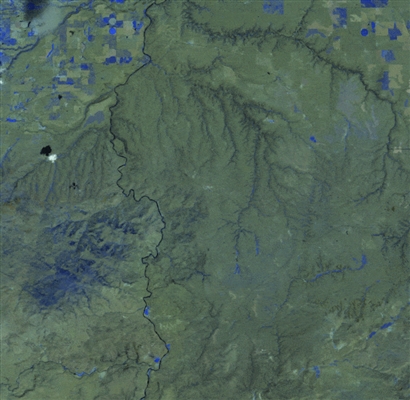A crooked nose doesn't paint anyone. But this is only the aesthetic part of the problem. Moreover, the curvature of the nasal septum is different and is not always too noticeable from the outside. However, this is a serious defect that can lead to the development of a number of serious chronic diseases. In a child with a congenital curvature of the nasal septum, the consequences can be clearly manifested only in adolescence, although the first symptoms appear as early as 6-7 years. Therefore, it is necessary to identify and eliminate any deformations as early as possible.
Structure and function
 To understand how and why the deformation of the nasal septum occurs, it is necessary at least in general terms to know the principles and features of its structure. The hard part of the nose, which we call the "back", inside divides its cavity into two equal canals. These are the nasal passages, lined with a mucous membrane covered with very small villi.
To understand how and why the deformation of the nasal septum occurs, it is necessary at least in general terms to know the principles and features of its structure. The hard part of the nose, which we call the "back", inside divides its cavity into two equal canals. These are the nasal passages, lined with a mucous membrane covered with very small villi.
Passing through these channels, the air is warmed up, cleaned of dust and dirt (they are retained by the villi), and slightly moistened. When an infection enters the upper respiratory tract or severe irritation of the nasal mucosa, an abundant secretion of mucus begins as a protective reaction of the body. It flows out through the nasal passages and cleanses the body of pathogenic microorganisms, preventing them from penetrating further.
The anterior part of the nasal septum consists of soft cartilaginous tissue that can be easily deformed. And only a small area located between the eye sockets is a thin bone.
The nasal septum is especially easily injured in infants and children under 2 years of age. It can be damaged with one careless movement. Although a small trauma to the nose is enough for an adult to be damaged.
Causes of the curvature
Nasal injuries of varying severity remain the most common cause of nasal septum deviation. Especially dangerous are multiple fractures of the cartilage and bones of the nose, when they cannot be healed perfectly correctly. Deformation can also occur during plastic surgery to change the shape of the nose, if it is performed by an insufficiently experienced specialist.
 Nose injuries are much more common in boys than in girls. This can happen during active sports (especially boxing, contact karate, etc.), outdoor games, and unsuccessful falls. In adults, it is common to injure the nose when the airbag is deployed during car accidents. And if a person is not secured with a seat belt, then the fracture can be very serious.
Nose injuries are much more common in boys than in girls. This can happen during active sports (especially boxing, contact karate, etc.), outdoor games, and unsuccessful falls. In adults, it is common to injure the nose when the airbag is deployed during car accidents. And if a person is not secured with a seat belt, then the fracture can be very serious.
Congenital deformities are extremely rare and can be caused by various genetic abnormalities. In a healthy baby, nasal cartilage can be damaged by inexperienced obstetricians during difficult childbirth. In childhood, such curvatures are easiest to correct, but they are quite difficult to detect. Most often this happens by accident on an X-ray when treating other pathologies.
Doctors also distinguish between compensatory curvatures, when deformation occurs due to uneven or abnormal growth of facial bones.
The nasal septum is gradually bent during the formation of polyps. As they grow, they put pressure on her and make her move to the side. Curvature is possible with an asymmetric structure of the nasal concha.
The main symptoms
It would seem that a slight curvature of the cartilage of the nose, which is not too noticeable from the outside and does not spoil the appearance, can be completely ignored. This is a common but fundamentally wrong opinion. The human body is a very complex biological system in which everything is interconnected. And even such seemingly insignificant deviations can lead to extremely undesirable consequences.
But before we figure out what a curved nasal septum threatens, let's find out what symptoms this deformation manifests itself with:
 Difficulty breathing when one of the nostrils is blocked. It is observed when the nasal septum is bent to one side, from which the width of the nasal passage can be significantly reduced.
Difficulty breathing when one of the nostrils is blocked. It is observed when the nasal septum is bent to one side, from which the width of the nasal passage can be significantly reduced.- Nosebleeds. May occur due to the fact that in the narrow place of the nasal passage, the mucous membrane is easily damaged when cleansing the nose or strong sneezing.
- Constant snoring. It appears due to the fact that air can no longer pass freely when inhaling, but meets resistance. The larger the curvature, the stronger the snoring.
- Dry mucous membranes. It arises from the side expanded due to the curvature of the septum. A larger flow of air passes through it, which does not have time to humidify. The walls of the nasal passage dry out, crack, and crusts form on them.
- Chronic diseases. The cause of constant sluggish inflammation in the nose is the accumulation of mucus, which is formed due to the fact that, due to the curvature of the nasal septum, it cannot freely go out.
- Allergy. Allergies can develop gradually if, with a strong curvature of the septum of the mucous membrane and the turbinate, they constantly touch.
- External deformation. This symptom is not always present. Slight curvatures may not be visible visually. Conversely, even with severe deformation of the cartilage from the outside, the nasal septum can remain flat.
When a slight curvature of the nasal septum was found on a randomly taken picture, but the signs listed above are completely absent, then you need to consult a doctor to determine the cause of the curvature.
If it is not compensatory, or bone growth has already stopped, then there is no need to intervene. But with pronounced symptoms, the consequences of curvature of the nasal septum can be serious.
What is dangerous curvature
In childhood and young age, the most common consequences of such deformities are various ENT diseases. Moreover, with age, such people become patients in ENT departments more and more often. After all, the cause of diseases does not disappear anywhere, so they smoothly turn into a chronic form, exacerbating each time with a drop in immunity or other favorable conditions.
 It usually starts with chronic rhinitis. With the abundant secretion of mucus, the body tries to compensate for the dryness of the nasal membranes, hinder the movement of cold air through the upper respiratory tract and provide the body with minimal protection. Thus, a runny nose becomes a constant companion of a person, even if there are no other symptoms of respiratory diseases: cough, fever, etc.
It usually starts with chronic rhinitis. With the abundant secretion of mucus, the body tries to compensate for the dryness of the nasal membranes, hinder the movement of cold air through the upper respiratory tract and provide the body with minimal protection. Thus, a runny nose becomes a constant companion of a person, even if there are no other symptoms of respiratory diseases: cough, fever, etc.
Due to the curvature of the nasal septum, constantly flowing mucus cannot freely leave the nose and begins to accumulate in the sinuses: frontal, maxillary, etc. stagnation of mucus, moisture and warmth. This provokes an active inflammatory process, and then sinusitis or frontal sinusitis, which easily turns into a chronic form.
If the situation is not constantly controlled, then infected mucus flows down the back wall of the larynx and enters the bronchi or through the Eustachian tube into the middle ear. The consequence is such unpleasant diseases as bronchitis and otitis media (often purulent). If untreated, meningitis and pneumonia develop. Chronic otitis media threatens with partial or complete hearing loss. Untreated bronchitis often turns into bronchial asthma.
Often adults are no longer willing to take measures to align the septum in adulthood. But only because they do not understand why the curvature of the nasal septum is dangerous for the elderly. The constant decrease in immunity in the presence of chronic ENT diseases leads to the fact that they more and more often "pick up" various infections, which become more difficult for a weakened body to fight.
The lungs and heart also work with increased stress, as they have to constantly overcome additional air resistance. But if at a young age the additional load is easily tolerated, then in the elderly it becomes the cause of the development of cardiovascular insufficiency and signs of oxygen starvation. And the lack of oxygen has a negative effect on the work of all organs and systems.
What to do?
 If you constantly have the symptoms listed above, you should consult an otolaryngologist with them. After a visual examination, he will prescribe the necessary tests and additional examination methods that will clarify the causes, the degree of curvature of the nasal septum, and the type of deformity.
If you constantly have the symptoms listed above, you should consult an otolaryngologist with them. After a visual examination, he will prescribe the necessary tests and additional examination methods that will clarify the causes, the degree of curvature of the nasal septum, and the type of deformity.
Based on the results of the examination, the doctor decides whether surgical correction is necessary or whether conservative methods of treatment can be dispensed with. But before dealing with the deformation itself, it is necessary to eliminate all the inflammatory processes that are currently taking place in the body. This can be done with medication and physical therapy.
Modern non-surgical methods of correction make it possible to correct minor curvature of the nasal septum using a laser or manual action on soft cartilage tissue (osteopathy). At a young age, it is sometimes possible to align the back of the nose with the help of a rather long wearing of a special clothespin, which gently squeezes the cartilaginous tissue on both sides, giving it the desired position.
However, with significant curvatures, these methods will not bring the desired result. Then septoplasty becomes necessary - a special operation to correct the deformation of the nasal septum. Depending on the situation, it can be performed by inserting surgical instruments through the nasal passage or through a small external incision. The decision on the course of the operation is made on a case-by-case basis.
Prevention measures
It is much easier to avoid the deformation of the nasal septum than to get rid of it. Therefore, it is worth taking care of the beauty and health of such an important respiratory organ from an early age. The mother should provide the child with proper care for the nasal cavity, she also instills the first hygiene skills, ignoring which can also cause chronic ENT diseases.
 The basis for the prevention of curvature of the nasal septum are the following measures:
The basis for the prevention of curvature of the nasal septum are the following measures:
- regular and correct cleansing of the nose without the use of cotton swabs and other hard objects;
- timely treatment of rhinitis and acute inflammation of the sinuses of the nose (sinusitis, sinusitis, frontal sinusitis);
- a mandatory visit to a doctor with the periodic appearance of allergic or inflammatory symptoms on the nasal mucosa;
- correct use of the safety system when driving a car;
- when engaging in traumatic sports, the use of special equipment to protect the face from injury.
If you decide to undergo aesthetic nose reshaping surgery, be sure to have it performed by a high-level specialist.
After suffering a nose injury with damage to the cartilaginous bone, be sure to take an X-ray to make sure that the nasal septum is not deformed. Thus, it will be possible, if not to prevent, then at least quickly correct the curvature, preventing the appearance of its unpleasant consequences.

 Difficulty breathing when one of the nostrils is blocked. It is observed when the nasal septum is bent to one side, from which the width of the nasal passage can be significantly reduced.
Difficulty breathing when one of the nostrils is blocked. It is observed when the nasal septum is bent to one side, from which the width of the nasal passage can be significantly reduced.

